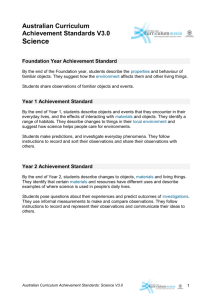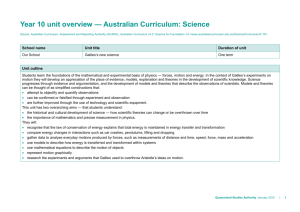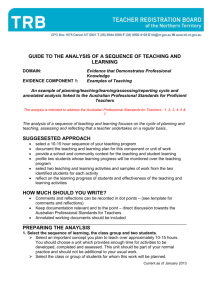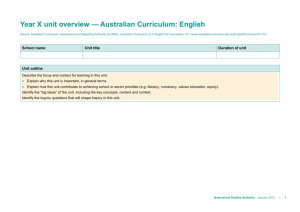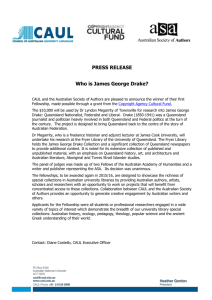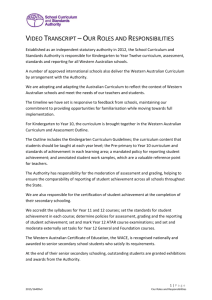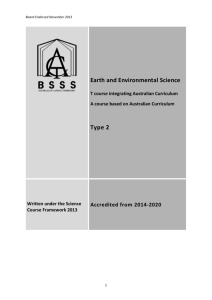Year 8 unit overview * Australian Curriculum: Science
advertisement
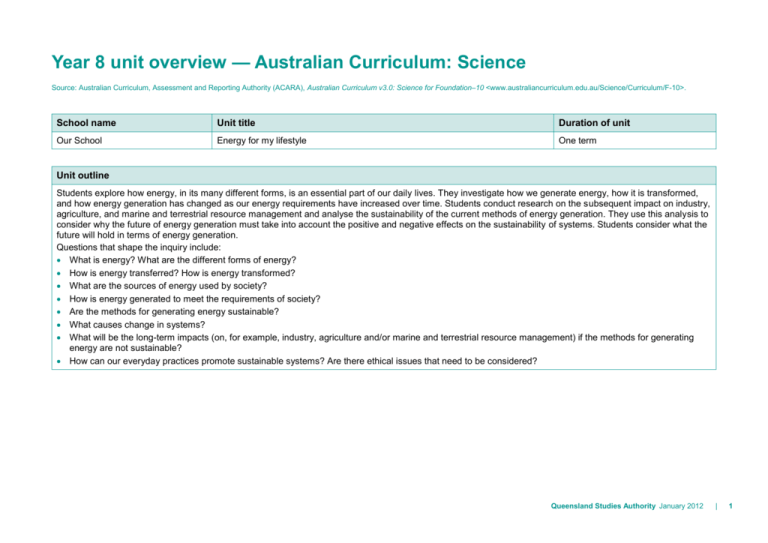
Year 8 unit overview — Australian Curriculum: Science Source: Australian Curriculum, Assessment and Reporting Authority (ACARA), Australian Curriculum v3.0: Science for Foundation–10 <www.australiancurriculum.edu.au/Science/Curriculum/F-10>. School name Unit title Duration of unit Our School Energy for my lifestyle One term Unit outline Students explore how energy, in its many different forms, is an essential part of our daily lives. They investigate how we generate energy, how it is transformed, and how energy generation has changed as our energy requirements have increased over time. Students conduct research on the subsequent impact on industry, agriculture, and marine and terrestrial resource management and analyse the sustainability of the current methods of energy generation. They use this analysis to consider why the future of energy generation must take into account the positive and negative effects on the sustainability of systems. Students consider what the future will hold in terms of energy generation. Questions that shape the inquiry include: What is energy? What are the different forms of energy? How is energy transferred? How is energy transformed? What are the sources of energy used by society? How is energy generated to meet the requirements of society? Are the methods for generating energy sustainable? What causes change in systems? What will be the long-term impacts (on, for example, industry, agriculture and/or marine and terrestrial resource management) if the methods for generating energy are not sustainable? How can our everyday practices promote sustainable systems? Are there ethical issues that need to be considered? Queensland Studies Authority January 2012 | 1 Identify curriculum Content descriptions to be taught Science Understanding Science as a Human Endeavour Science Inquiry Skills Physical sciences Energy appears in different forms including movement (kinetic energy), heat and potential energy, and causes change within systems Use and influence of science Science and technology contribute to finding solutions to a range of contemporary issues; these solutions may impact on other areas of society and involve ethical considerations Questioning and predicting Identify questions and problems that can be investigated scientifically and make predictions based on scientific knowledge (ACSIS139) Planning and conducting Collaboratively and individually plan and conduct a range of investigation types, including fieldwork and experiments, ensuring safety and ethical guidelines are followed (ACSSU155) (ACSHE135) Science understandings influence the development of practices in areas of human activity such as industry, agriculture and marine and terrestrial resource management (ACSHE136) 2 | Year 8 unit overview Australian Curriculum: Science (ACSIS140) In fair tests, measure and control variables, and select equipment to collect data with accuracy appropriate to the task (ACSIS141) Processing and analysing data and information Construct and use a range of representations, including graphs, keys and models to represent and analyse patterns or relationships, including using digital technologies as appropriate (ACSIS144) Summarise data, from students’ own investigations and secondary sources, and use scientific understanding to identify relationships and draw conclusions (ACSIS145) Evaluating Reflect on the method used to General capabilities and cross-curriculum priorities Literacy Write reports. Communicate using scientific terminology. Numeracy Make measurements. Analyse data to identify trends. Construct graphs to represent and analyse data. ICT capability Use data loggers to gather experimental data and spreadsheets as a tool to perform calculations. Critical and creative thinking Use thinking skills to complete group activities and open-ended tasks. Ethical behaviour Consider how the actions of people impact on the sustainability of systems. Personal and social capability Work together to participate in science investigations and learning experiences. Asia and Australia’s engagement with Asia Investigate the development of investigate a question or solve a problem, including evaluating the quality of the data collected, and identify improvements to the method (ACSIS146) Use scientific knowledge and findings from investigations to evaluate claims (ACSIS234) sustainable energy sources and technologies in the Asia–Pacific region. Sustainability Debate how emerging energy technologies improve the sustainability of resources. Communicating Communicate ideas, findings and solutions to problems using scientific language and representations using digital technologies as appropriate (ACSIS148) Achievement standard By the end of Year 8, students compare physical and chemical changes and use the particle model to explain and predict the properties and behaviours of substances. They identify different forms of energy and describe how energy transfers and transformations cause change in simple systems. They compare processes of rock formation, including the time scales involved. They analyse the relationship between structure and function at cell, organ and body system levels. Students examine the different science knowledge used in occupations. They explain how evidence has led to an improved understanding of a scientific idea and describe situations in which scientists collaborated to generate solutions to contemporary problems. Students identify and construct questions and problems that they can investigate scientifically. They consider safety and ethics when planning investigations, including designing field or experimental methods. They identify variables to be changed, measured and controlled. Students construct representations of their data to reveal and analyse patterns and trends, and use these when justifying their conclusions. They explain how modifications to methods could improve the quality of their data and apply their own scientific knowledge and investigation findings to evaluate claims made by others. They use appropriate language and representations to communicate science ideas, methods and findings in a range of text types. Queensland Studies Authority January 2012 | 3 4 | Relevant prior curriculum Curriculum working towards In the Australian Curriculum: Science at Year 7 Science understanding Earth and space sciences Some of Earth’s resources are renewable, but others are non-renewable. Science as a Human Endeavour The content descriptions for Science as a Human Endeavour are the same for Year 7 and Year 8. Science Inquiry Skills The content descriptions for Science Inquiry Skills are the same for Year 7 and Year 8. In the Australian Curriculum: Science at Year 9 Science understanding Physical sciences Energy transfer through different mediums can be explained using wave and particle models. Science as a Human Endeavour Use and influence of science People can use scientific knowledge to evaluate whether they should accept claims, explanations or predictions. The values and needs of contemporary society can influence the focus of scientific research. Science Inquiry Skills Questioning and predicting Formulate questions or hypotheses that can be investigated scientifically. Planning and conducting Plan, select and use appropriate investigation methods, including field work and laboratory experimentation, to collect reliable data; assess risk and address ethical issues associated with these methods. Select and use appropriate equipment, including digital technologies, to systematically and accurately collect and record data. Processing and analysing data and information Analyse patterns and trends in data, including describing relationships between variables and identifying inconsistencies. Use knowledge of scientific concepts to draw conclusions that are consistent with evidence. Evaluating Evaluate conclusions, including identifying sources of uncertainty and possible alternative explanations, and describe specific ways to improve the quality of the data. Critically analyse the validity of information in secondary sources and evaluate the approaches used to solve problems. Year 8 unit overview Australian Curriculum: Science Communicating Communicate scientific ideas and information for a particular purpose, including constructing evidence-based arguments and using appropriate scientific language, conventions and representations. Bridging content The Australian Curriculum: Science prior to Year 8 focuses on specific types of energy, i.e. heat (Year 3) and electricity (Year 6). The Year 7 Essential Learnings: Energy and change address different forms of energy and the changes that they cause in a system (by being transferred and transformed). Links to other learning areas In the Australian Curriculum: Mathematics at Year 8 Choose appropriate units of measurement. In the Australian Curriculum: English at Year 8 Use comprehension strategies to interpret and evaluate texts by reflecting on the validity of content and the credibility of sources, including finding evidence in the text for the author’s point of view. Queensland Studies Authority January 2012 | 5 Assessment Describe the assessment Assessment date Students are given opportunities to demonstrate their knowledge, skills and understanding through both formative and summative assessment. The assessment is collated in student folios and allows for ongoing feedback to students on their learning. Year 8 teachers make decisions about the length of time required to complete the tasks and the conditions under which the assessment is to be conducted. The teaching and learning experiences throughout the term provide opportunities for students to develop the understanding and skills required to complete these assessments. As students engage with these learning experiences the teacher can provide feedback on specific skills. Assessment task Students respond to the following statement: Discovering new fossil fuel resources and developing new technologies to exploit current sources of fossil fuels are shortterm solutions to the energy crisis. A long-term solution is to develop sustainable energy sources and technologies. Part A: Experimental investigation — Scientific report (Written) Collaboratively design a fair investigation to collect quantitative data to determine the effect on energy production of, for example: clouds and solid pollutants on a solar cell angle or direction of a solar cell number of blades or length of blade on a wind turbine colour of a solar oven. Suggested conditions: 100–400 words open. Weeks 6–7 (approximately) Part B: Research — Report (Written) Undertake an individual research task to investigate sustainable energy sources and technologies. Choose a sustainable energy technology, for example: biodiesel geothermal power windmills 6 | Make judgments Year 8 unit overview Australian Curriculum: Science Teachers gather evidence to make judgments about the following characteristics of student work: Understanding description and identification of scientific facts, ideas, concepts, and phenomena use of science knowledge to generate solutions and explanations description of the application of science knowledge to solve real-world and contemporary problems Skills construction of questions and problems that can be investigated scientifically planning of investigations that take into account the need for fair testing and safety summary of data and information to identify and describe patterns and trends and to draw conclusions description of how methods and modifications to methods could improve the quality of data evaluation of claims with links to science knowledge communication using appropriate scientific language and representations. For further advice and guidelines on constructing guides to making judgments refer to the Learning area standard descriptors: www.qsa.qld.edu.au Assessment Make judgments rechargeable batteries solar ovens hybrid cars fuel cells. For the chosen energy technology: identify the energy source identify the use of the produced energy describe how the technology uses its energy source to achieve its purpose draw a Sankey diagram to identify the energy transfers and transformations and where energy is wasted give the advantages and disadvantages of using this technology compare your energy source to existing technology that has the same purpose. Does your energy source present a better option? Why or why not? Justify your position. Suggested conditions: 100–200 words open. Queensland Studies Authority January 2012 | 7 8 | Teaching and learning Supportive learning environment Teaching strategies and learning experiences Adjustments for needs of learners Resources Throughout the term students complete investigations to explore energy transfers and transformations. In preparation for the assessment, they write scientific reports to communicate the results of investigations. The skills learnt while completing these introductory investigations will be used to: identify problems and make predictions design and conduct their own fair investigation based on research conduct a risk assessment of the investigation collect and display data using a range of formats process and analyse data collected link the theory to explain results obtained from investigation justify conclusions. Compile a glossary of terms, including: energy, kinetic energy, gravitational potential energy, chemical potential energy, elastic potential energy, solar energy, heat energy, electrical energy. Explore with the goal of answering the question: What is energy? Conduct investigations to build an understanding of the different forms of energy and how energy is measured. Conduct investigations to explore the idea that energy changes, transfers and transforms to make things happen, e.g. What happens if … ? What effect does … ? Identify and explain energy transfers and transformations in everyday activities and contexts such as: household appliances electrical circuits toys playground equipment solar cells wind turbines. Represent the flow of energy transfers and transformations using Sankey diagrams. Section 6 of the Disability Standards for Education (The Standards for Curriculum Development, Accreditation and Delivery) state that education providers, including class teachers, must take reasonable steps to ensure a course/program is designed to allow any student to participate and experience success in learning. The Disability Standards for Education 2005 (Cwlth) is available from: <www.ag.gov.au> select Human rights and anti-discrimination > Disability standards for education. Web websites for factsheets YouTube clips Print textbooks worksheets Equipment solar panels wind turbines toys operated by battery, springs and/or gravity household appliances such as toaster, kettle, iPod Safety equipment teacher-completed risk assessment for experimental learning experiences student-completed risk assessment for assessment Year 8 unit overview Australian Curriculum: Science Teaching and learning Supportive learning environment Teaching strategies and learning experiences Adjustments for needs of learners Resources Understand where the energy required for our lifestyle comes from and the technologies used to change it into the form needed to use it. Conduct a scan of news media to identify current issues and debates about energy at a local, national and global scale. Appreciate the impact of an energy-dependent lifestyle (on, for example, industry, agriculture, and marine and terrestrial resource management). Explore sustainable sources of energy in a variety of contexts. Explore to answer the questions: Why do alternative energy sources and technologies need to be researched and developed? Are these alternative energy technologies more sustainable? What are the limits of the energy technologies? What does the future hold? Where are we going? Where have we come from? What are the ethical issues that need to be considered when deciding how to use or source energy? Queensland Studies Authority January 2012 | 9 Use feedback 10 | Ways to monitor learning and assessment Teachers collaboratively plan the teaching, learning and assessment to meet the needs of all learners. Teachers mark a small random sample of the research task and investigation design report, moderate the samples to ensure consistency of judgments, then mark their own class. Feedback to students Teachers plan opportunities through the teaching strategies and learning experiences of the unit. Teachers provide ongoing feedback and encouragement to students on their strengths and areas for improvement. Through particular learning experiences students can reflect on and discuss with their teachers and peers what they are able to do well and what they need to do to improve, e.g. identifying patterns and trends in experimental data, analysing the sources of error in the data collected. Reflection on the unit plan At the conclusion of the unit all teachers who have been involved in planning, teaching, learning and assessment come together to reflect on the successes and challenges of the unit. They come with their personal reflections through answers to the following questions: What worked well in this unit? What was a stumbling block? How would you refine it? What trends and gaps in learning have you identified? How will you build on these learning experiences next term and beyond? Year 8 unit overview Australian Curriculum: Science
